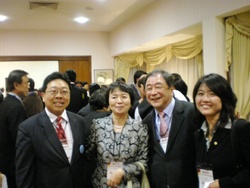今回の南米訪問最大の目的は、ウルグアイの首都モンテビデオで開催された第15回目のパンアメリカン日系人大会COPANIに出席することであった1。南山大学の浅香幸枝先生とサンパウロ大学の二宮正人教授とともに移民ワークショップで、筆者は日本の南米日系人について発表したのである。
二年ごとに開催される同大会では、米州の日系人の有力者が集まり様々な議題を議論するのだが、横のつながりを強化し、親善の促進が主である。弁護士や法律学者という専門家の会合もあり2、ユース会合もある。今回、後者がかなり注目を集め、頼もしい発表がいくつかあったのだが、結論に「…日系人とは違いを主張するのでなくて、違いをプラスに変える力を持っている人たちである」ということが印象に残った。中南米のほとんどの日系社会は100年の歴史を超えており、世代も三世、四世が中心で非日系人との混血化も自然と進んでいる。そうした中、「ニッケイ人」のアイデンティティということにあまりにもこだわり過ぎると時には違いを強調し過ぎる結果を招いてしまう。
これまでどの国の日系社会も地元社会との共存を重視しながら、二世以降には同化もしくは社会統合を促進し、社会の一員としての活躍が期待されてきた。その結果、各分野で成功している日系人はたくさんいるが、社会の一員になるためには社会の歪みや構造的な問題に翻弄されてきたともいえる。生まれ育った社会・家庭環境によっては、日系人だということをあまり意識しなくてもいいということもあれば、意識しなくてはならないというケースもあるが、これは時代や国の情勢によっても左右されるもので、複雑な要素が絡み合っている。
COPANIは、そうしたジレンマや違いに何らかのヒントを与えてくれる国際的な会合であり、国境や世代を越えて目的意識が異なっていても参加できる場であり、様々な教訓を共有できる場である。参加費や渡航費、宿泊費等をみると確かに誰もが気さくに参加できる大会ではないためエリート主義だという指摘もあるが、アメリカ大陸の各リーダーや有力者たちが集まれる場はこれしかなく、有意義な会合にするかどうかは参加者次第である。
今回はモンテビデオで開催されたが、日本人移民及び日系人が非常に少ない国であるため、アルゼンチンやチリ等、周辺諸国が側面的に支援し、できるだけ多くの若者が出席できるようOBら、主に創設者の一人であるメキシコのカルロス春日氏の財政協力(若者の参加費免除や宿泊費助成)もあった。
ウルグアイの日系人社会は600人ぐらいだが、チリと同様、日本人の集団移民はなかったのである。世代も進み、2008年には日本人移民100周年を迎えている。戦後に移住した者の中には、今も花卉栽培やクリーニング屋で生計を立てている人もおり、それはブエノスアイレスにいる日系人と類似した特徴である。
日本では、ウルグアイ東方共和国のことはあまり知られていないが、歴史的にはブラジルやアルゼンチンという大国の狭間で、したたかに利害関係を調整しながら、隣国と協調してきた国である。南米のスイスと言われるぐらい金融機関の信用度は高く、政治的にも安定しており、経済的にも農牧国として付加価値の高いアグロインダストリー関連の輸出産業を発展させている。輸出の20%は肉類で、14%が穀物や米であり、ワインや衣類等も近年伸びている。この国を代表するワインの銘柄はタナ(Tannat)であり、ちょっとこってりした甘辛い和食料理には非常に合う3。肉料理も豪快で、アルゼンチンに負けないボリュームで知られる。
高級リゾート「プンタ・デル・エステ」にはアルゼンチンだけではなく、南米の富豪が別荘を持っている。そして世界遺産登録されている「コロニア・デル・サクラメント」では4、新規高級ホテルやリゾートマンションが建設され、フェリー港の拡張工事も行われている。年間200万人の外国人観光客による外貨収入は国民総生産の6%を、サービス部門の収入の48%を占めている。アメリカや欧州、南米主要都市からの直行便も増え、以前より行きやすくなっている。また、多くの大型旅客船(クルーザー)も停泊するため、これらに対するサービスや市内観光も大きな収入源である。
鉱物資源の輸出も増えており、林業開発の事業ではウルグアイ川に大規模な製紙工場を建設している。
ウルグアイの人口は横浜市より少ない程度の330万人であるが、国土の面積は日本のちょうど半分である。国民総生産が約330億ドルで、一人当たりの年間平均所得は9,000ドルなので、ブラジルやアルゼンチンのより高く、あまり大きな社会的格差がなく教育水準も高いというのも特徴である5。
イタリアやスペインからの移民が多いため、文化的人種的には隣国のアルゼンチンに似ている部分も多いが、17世紀以降アフリカから連れてこられた奴隷の影響もあってブラジル北東部のような黒人文化もある。それが、カンドンベという音楽、舞踊に現れているが、非常にリズミカルでウルグアイのカーニバルには欠かせないパレードである6。
国民も穏やかで、移民構成が似ているブエノスアイレスとは違った味を出しており、南米の中では最も住みやすい国の一つである。
政治の安定も南米では手本になっており、12月には任期を終えたバスケス・タバレス大統領が来日し、同じ政党内での政権交代とはいえ、元ゲリラ活動家であるムヒカ氏(次期大統領、2010年3月に就任)を全面的に支える旨アピールした7。
注釈:
1. http://www.apnonline.net/ APNについて(西語のみ)
2. http://www.apj.org.pe/fopan/historia FOPANについて(西語のみ)
3. http://www.e-food.jp/wine/urguay.html ウルグアイのワインについて
4. http://www.mercosur.jp/04_uruguay/isan_colonia.html
5. http://www.mofa.go.jp/mofaj/area/uruguay/index.html
http://www.uy.emb-japan.go.jp/index%20japones.htm
http://www.uruguay.gub.uy/estado/default.asp
6. http://asakawa-kats.com/uruguay/llamada.html
http://asakawa-kats.com/uruguay/index.html
7. http://www.mofa.go.jp/mofaj/area/uruguay/visit/0912.html
© 2010 Alberto J. Matsumoto










